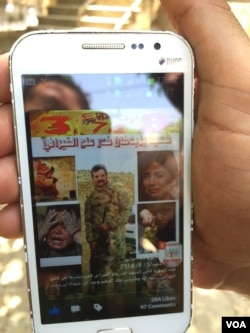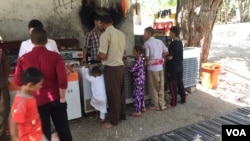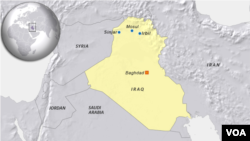A year ago, on August 3, Islamic State militants stormed the homelands of Iraq’s Yazidi minority, killing hundreds of men and enslaving thousands of women.
The scenes of desperate Yazidi families crowding on the top of Sinjar mountain without food or water spurred Kurdish fighters into action, an emergency airlift and the start of the U.S. airstrike campaign against the Islamic State Sunni extremists.
Yazidis who survived that massacre are scattered around the region. About a two hour drive north of the northern Kurdish city of Irbil, amid dusty, rocky hills is Lalish, the site of a famous Yazidi shrine. On this Sunday, a day before the anniversary, Yazidi families are walking into the shrine grounds in 50-degree (Celsius) heat to meet, pray and wash in the holy waters of their temple.
'There was no food, no water'
Murad Aloo, is one of them. Wearing all black, he walks around the temple grounds, stopping at the stand selling water and ice cream. But he finds little peace here. The images of what happened 12 months ago is seared into his mind.
On that day, he said, the shooting started at around 10 in the morning. When the Yazidis realized they were going to be slaughtered by the oncoming Islamic State militants, they fled by the thousands to Sinjar mountain.
“I will never forget what happened. I saw mothers leaving their daughters behind, fearing for their own lives. I saw women and men being slaughtered, even pregnant women.”
Aloo pulls out his cell phone to show a picture of his brother. Aloo says his brother decided to stay and fight for Yazidi land, and he has never seen him again.
Remembering the days that followed, stranded on Sinjar mountain, waiting for the airlift and a way out, Aloo starts crying.
“We had one capful of water for two children. There was no food, no water. Many died of thirst and hunger when we were stranded on the mountains. God, God.”
Shrinking population
Around the temple, women and girls walk barefoot, washing in the holy waters. One small child rinses ice cream sticks in the water, while others fill plastic bottles with water from a pipe sticking out of stone wall.
These are the lucky ones. Not all are from Sinjar, but those among them who fled the slaughter are haunted. The Islamic State extremists who consider the Yazidis devil-worshippers, executed the young men, raped little girls and enslaved thousands of women.
For Yazidis, a minority community in Iraq, and a religious group that has under a million members in the world, being killed and driven from their ancestral Iraqi land is a death sentence.
Sheikh Ismail Murad Qasim, another survivor, sits in the cool of a stone grotto, and mourns the death of his community.
“This is the end of our people. They have massacred us by the thousands, raped eight- and nine-year-old girls, the future of our Yazidi community. And now they are all killed.”
The spiritual elders of the shrinking population are trying to keep their people together, encouraging them not to leave Iraq. But they acknowledge the challenge.
“We call for the protection of the Yazidis. We are alone. We have no one to turn to. And we pray, we pray for God to bring harmony among all religions,” Baba Sheikh, the Yazidi’s spiritual leader, told VOA.
No 'future for me'
Aloo is too traumatized to even think of that kind of harmony.
“I wish I were among the dead, instead of witnessing what I have seen. I don’t think there is a future for me, I am just so heartbroken, I don’t think there is a future for me.”










